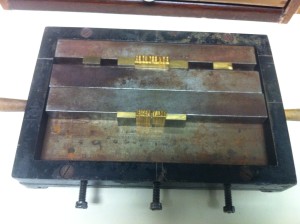My notes from the day (barely written up)
- Initial conversations immediately revealed a ‘gap’ in language between archivists and artists working in archival collections. The phrase ‘creating an archive’ was constructively shot down by a leading archivist saying that archives are never ‘created’, they form organically through use, need and event. (And engagement with them will point back to those facts.) This notion made me think of the category in the Birmingham University Cadbury Library, of ‘artificial archives‘, in other words collections put together by a single person, deliberately appropriating items into a set. It’s their historical determination now that points to that fact of that collection and makes it an archive – rather than any enthusiast’s collections having archival status.
- (This assertion that archives are never created made me wonder where the space is for artistic intervention in them. Models of engagement and navigation can be pre-emptive and ‘creative’)
- This point was emphasised – ‘Archives are anything that tells you who-what-where-when-how-why’ – An archive is the stuff, the place is arbitrary.
- An interesting difference that was pointed out between archives and museum collections is the issue of ownership. Archives are held on a permanent loan basis – they sit in the institutions and libraries purely to be preserved and for the sake of access. This is a key political point, in contrast to museum/gallery collections where a huge amount of effort is put into clarifying ownership and securing that.
- (The more I learn about the mechanisms of archives the more I feel they suit the discursive nature of the kind of art (and poetry) I’m into – artwork that resists commodity, single object, primary document. In archives the emphasis is on access and engagement, telling the whole story including the metadata, including the dirge and the shit, not claiming ownership, just presenting the material.)
- The issue of metadata is a practical one as well as ethical – an email thread has to be archived with its contextual information otherwise it means nothing and isn’t strictly ‘provable’
- The issue of media-specific artwork came up particularly when specific to unstable media. (Jpeg art is the a good way forward.)
- A reflective moment considered that all this anxiety over archives is a cultural quirk. We are a record keeping culture and have been since medieval times. Our notion of heritage is culture-specific. An archive made in the UK of Chinese records is not a Chinese archive, but a British archive of Chinese records.
- Overall the day framed the relationship between the arts and archives as a pretty standard engagement. An arts organisation or individual would research an archive and then create an art product based on that research. I am interested in the act of archiving, the act of navigating and negotiating an archive being the site of practice.
- Altogether there was an over emphasis on funding strategies and preservation issues, rather than critical thinking about how the mechanisms relate to each other. (someone asked, what about Fluxus?)






























